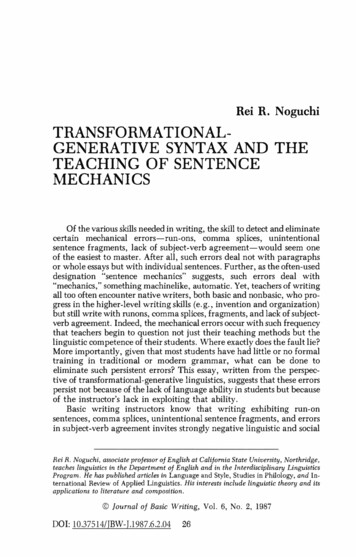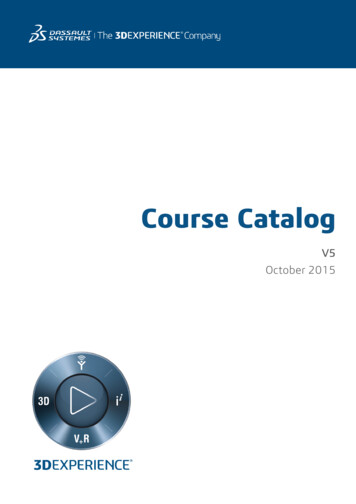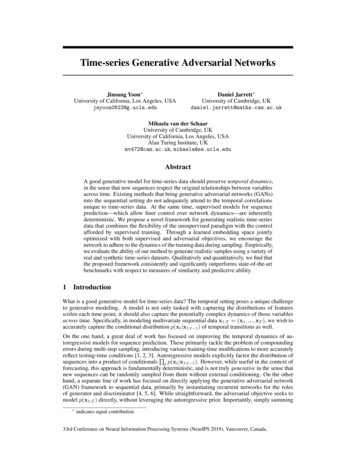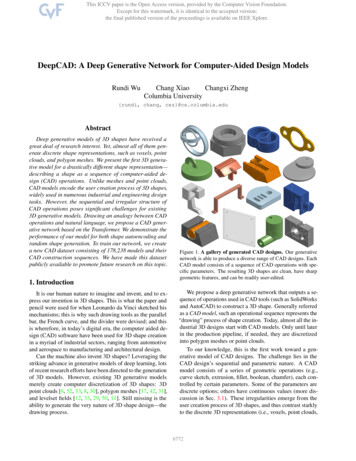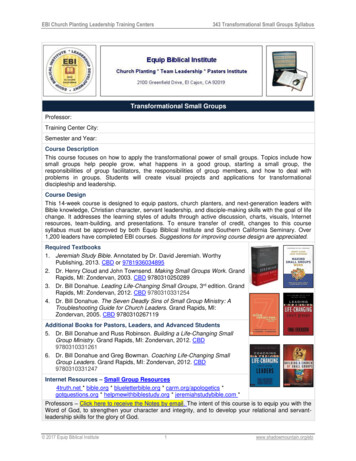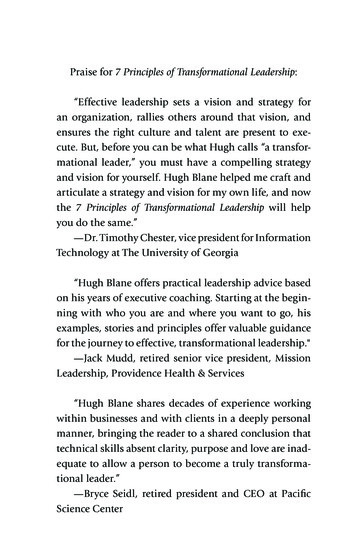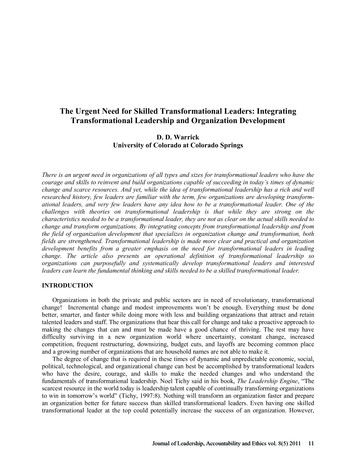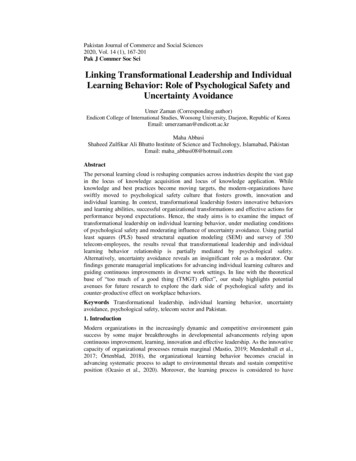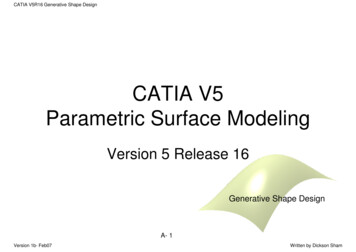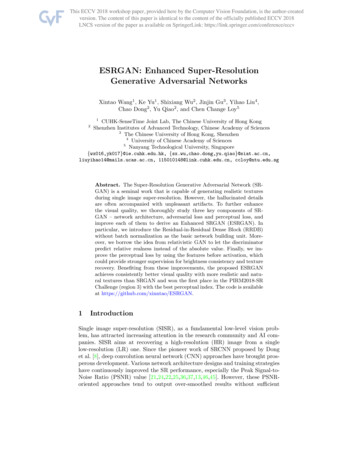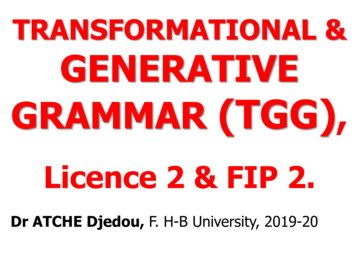
Transcription
TRANSFORMATIONAL &GENERATIVEGRAMMAR (TGG),Licence 2 & FIP 2.Dr ATCHE Djedou, F. H-B University, 2019-20
GENERAL OBJECTIVE:Learners will knowthe Basicsof Transformational& GenerativeGrammar(Generativism)
SPECIFIC OBJECTIVES: Learners should be able toaccount for the following:1234-Syntactic Theory;Standard Theory;The Kernel Sentence;Generative & TransformationalFeatures;5- The Notion of Grammaticality6- Universal Grammar
SOME REFERENCES Chomsky, N. (1957) Syntactic Structures). Mouton Chomsky, N.(1965). Aspects of the Theory of Syntax. MITPress. Chomsky, N. (1995). The Minimalist Program. MIT Press. Radford, A. Transformational Grammar: A First Course.Cambridge Textbooks in Linguistics. 1988. Lyons, J.(1977) Chomsky. Fontana. Collins. Glasgow Huddleston, R. ( 1976) An Introduction to EnglishTransformational Syntax. Longman. Jackendoff, R.S. (1972) Semantic Interpretation inGenerative Grammar. MIT Press. Cambridge. Nicolas RUWET. (1967) Introduction à la GrammaireGénérative, Paris, Plon. Waria Omar Amin. (2012). ‘Models of Generative Grammar’Iraqi Academic Scientific Journal.
INTRODUCTION (1) In 1957 Noam CHOMSKY, an AmericanLinguist, published Syntactic Structures, .&Generative This grammar has had a profound effect onthe study of all languages, including English. It was a reaction against structuralism andthe first model to acknowledge formally thesignificance of Deep Structure.
INTRODUCTION (2) Transformational Grammar strongly criticizedStructural Linguistics on the ground that thistheory was describing language as a finalproduct. AccordingtotheadvocatorsofTransformational and Generative Grammar(TGG), a sound linguistic theory should try andexplain how sentences are produced. For them, a sound theory should describe thelinguistic operations involvedproduction of sentences.inthe TGG then claims to be a grammar of production.
INTRODUCTION (3) The objective is to create an explicit model ofwhat an ideal speaker of the languageintuitively knows. The model must assign a structure, therefore,to all the sentences of the language concernedand only to these sentences. From its initial version in the mid-1950s uptoday, TGG has gone through severalreformulations; Noam Chomsky was always prepared to revisithis theory of the speaker’s Competence eachtime his detractors would raise new syntacticdifficulties;
INTRODUCTION (4) However,whateverthemodificationsreinserted, from the first Formulation (F1)to the subsequent versions with theUniversal Grammar Hypothesis via theParameterHypothesisuptotheMinimalist Program, some cardinalconcepts have remained; SuchisthecaseofthenotionsofTransformation Rules, Competence andPerformance, Cognitive Dimension of thehuman language, etc.
I- BASIC ASSUMPTIONSAll Chomsky’s theory (TGG) evolves around4 basic questions:1- What is language?2- What do we know when we say that we know alanguage?3- What are the defining characteristics between naturallanguages and other systems of communication?4- Are languages really different? And to what extent dothey differ? And if they are different, do they differ in anunpredictable way? In answering these questions, two mainconcepts stand out: the Innateness ofLanguage,andCompetence&Performance.
1.1- The Innateness of Language (1) It is the assumption that our mother tonguedoes not come from the outside world, butit is originated from inside the individual. Admitting that language is innate is alsoadmitting that a native language cannotbe acquired through imitation. Native languages are not learned, theysimply develop all along the cognitivedevelopment.
1.1- The Innateness of Language (2) When we consider the complexity ofhuman languages and the way they areeasily acquired by young children, weare compelled to admit that not all the rulesthey use to speak the language come fromthe outside. Chomsky finds two types of evidence toshow Language Innateness: The positive Evidence & The Negative Evidence
1.1.1- The Positive Evidence (1) It is the existence of concrete facts indicatingthat young children rely on a built-insystem to progressively master their nativelanguage. From exposure to a certain linguistic input,children will learn very limited number ofstructures, and from these, they are able tomake their own verbal production. By approximation, they manage to develop arelatively correct grammar over time;
1.1.1- The Positive Evidence (2) The fact that they produce correct sentencesthey have never heard before is an evidencethat the principles of such structures preexisted to the incoming linguistic input. In other words, since they know thesentence structure, they can producesome new sentences just by following therules! And this capacity of creating novel structuresis possible because of the LanguageAcquisition Device (LAD).
1.1.2- Negative Evidence(La Preuve de l’Absurde) (1) In their linguistic exposure, children areexposed to a Limited Input, and sometimesto a distorted input. This mean that around them, adults andparents sometimes will speak with mistakes. But children do not appear to reproduce thesame mistakes though they are notnecessarily taught device in their mind thatdoes not make home for any kinds of wrongcombinations.
1.1.2- Negative Evidence(La Preuve de l’Absurde) (2) So, it is as if the psychological apparatus wererefuting the combinations that do not fit in ourmind. Young children or learners of a second languagedo not make any kind of mistake. We can predict some mistakes learnerswill never make.E.g. “Le table” or “le table est petite”, or “la femmea donne trois cahiers” are possible mistakes. But mistakes such as “cahiers a femme trois ladonne” are not possible.
1.1.2- Negative Evidence(La Preuve de l’Absurde) (3) The last sentence is very unlikely in themistake repertoire of the French languagebecause it does not comply with the internallogic of sentence structure whereby we dividesentences into two immediate constituents. The fact that some mistakes are almostimpossible is the evidence that long beforeacquiring their linguistic experience fromadults, the logical system of children rejectssome combinations as impossible, becausethey do not fit in the cognitive system oflearners.
1.1.2- Negative Evidence(La Preuve de l’Absurde) (4) The logical organization of the sentence isanterior to the linguistic experience oflearners. No language is easier or more difficultthan other languages. The difficulty to learn a language comesfrom reasons, which are not linguisticfactorsbutfromsocialandpsychological factors.
1.1.2- Negative Evidence(La Preuve de l’Absurde) (5) The complexity of languages is justapparent. It is a mere surface perception. All languages function according to thesame universal principles. So, we can oppose the surface level’sapparent complexity to an underlyingorganization, and this is reflected in theopposition of Competence and Performance.
1.2- Competence & Performance1.2.1- Competenceis the tacit knowledge oflanguage rules that the speaker uses toproduce correct sentences in his language. Competence So, Chomsky defines it as ‘the ideal speakerhearer’s knowledge of his language’. The person who has acquired knowledge of alanguage has internalized a system of rules thatrelate sound and meaning in a particular way.
1.2.1- Competence The linguist constructing a grammar of alanguage is in effect proposing a hypothesisconcerning the internalized system. In other words, competence is the perfectstorehouse of linguistic knowledge. It is therefore a very powerful skill. Using his/her competence, the ideal nativespeaker can produce and understand allpossible sentences all his/her language.
1.2.1- Competence He/she can even decipher those he has neverheard before, that is, novel sentences. The speaker also uses his competence tomake correct judgement on sentences. Competence is not only at the level of syntax,it manifests itself at any level of languagepractice. In practice, competence is something complexand nowadays people distinguish several typesof competence.
Grammatical Competence It refers to the assimilation of grammar rules. E.g. 1- I thought Mary was sick, but it turned outthat she wasn’t. E.g. 2- He thinks that John is wrong. It is simply our knowledge or our experienceof English that shows that “she” refers to“Mary”, whereas “he” cannot be interpretedas “John” in the second sentence. Grammatical competence then belongs tolanguage structure: it is the intuitiveknowledge of the language.
Pragmatic Competence This type oflanguage use.competencebelongsto E.g. Today was a disaster! (says a politician) This sentence is difficult to interpret, unlesswe knew that the politician gave a speechthat completely went down.calls for nonlinguistic information for the productionand interpretation of the sentences. PragmaticCompetence
NOTA BENE: So, since its advent in the 1950s, TGGhas been constantly and dynamicallydeveloping; Chomsky and many linguiststhroughout the world have contributedto the different developments. So, TGG has undergone numerous andvarious Models & Reformulations.
Transformational & Generative GrammarSyntactic TheoryFormulation 1 (1957)
FORMULATION 1 (1) As early as the first Formulation (F1),Chomsky described the Ideal NativeCompetence as relying on basic modules asthis speaker produces a sentence. The generation or the sentence productionprocess goes through 3 modules. And the final sentence we hear from aspeaker is the result of this long-standingmental process.
2- The Three Components Thus, the native speaker operates alongthree modules named “components” throughwhich the sentence production process unfolds :a. The Base Component;b. The Transformational Componentc. The Morpho-Phonological Component. The speakers performs the required andspecific linguistic operations in eachcomponent until the surface level; In short, the sentence we hear is the result ofthe execution of diverse sorts of rules insidethe components aforementioned.
2.1- The Base Component The base component sub-divides into twosub-components that are the Category(categorial) Component and the LexicalComponent.2.1.1- The Category Component (1) This component contains category rewriterules and the sentence project appears in the formof grammatical categories only.
2.1.1- The Category Component (2) To produce a sentence like :The boy eats those mangoes The speaker performs the category rewrite rulesas follows:1. S NP1 VP2. NP Nber MN3. MN Det N14. VP Aux MV5. Aux T6. MV V NP.7. NP2 (go to rule 2)NB: Conventionally, the horizontal arrow ( ) reads “rewrites”
2.1.1- The Category Component (3) Surely this is not what we hear when someone speaks and this means that theconstruction of the sentence is not over; The speaker then moves to another type ofrewrite rules, the Lexical Rewrite Rules. For the sentence above, the lexical rewriterules are as follows and these are the LexicalInsertion Rules
2.1.1- The Category Component (4) Nbr SingDet TheN1 boyAux PresVerb eatNbr PlurDet thatN2 mango Once the Lexical Rewrite Rules are executed, thespeaker get the Deep Structure (DS) of the sentencealso named the abstract structure: DS : [sing. the boy Pres eat plur. that mango]
2.1.1- The Category Component (5) Once again, the Deep Structure is not whatwe use to speak to people, the construction of thesentence is still yet to be completed; Note: when you talk to someone you don’t tellhim!!! “my sentence will be in the presenttense, that the subject will be singular and theobject plural” At that level, the rules to apply in the BaseComponent are over and the speaker moves tothe following module, the TransformationalComponent.
2.2- The Transformational Component (1) This Component also contains rules, but rules oftransformations (or Transformational Rules); The utility and role of the transformational rulesis to convert the unfinished forms of the deepstructure into elements as they are in the Englishlanguage. And depending on the speaking objectives, thespeaker will resort to several transformationalrules some of which might involve substitution(commutation), displacement, ; Transformational rules are applied onelements contained in the Deep Structure.the
2.2- The Transformational Component (2) For the Deep structure built to have oursentence “The boy eats these mangoes” wewill have number of rules being applied,namely the Agreement Transformations: DS : [sing. the boy Pres eat plur. that mango] T Agr (DS) sing the sing. boy 3rd Pers Sing eat plu that plu mango
2.2- The Transformational Component (3) The Agreement transformation indicates thespecificity of the English language in that thereare syntactic agreements between theDeterminer and the Number category and thisagreement is also carried over onto the Noun. Similarly there are syntactic agreementsbetween the NP subject and the verb ,etc. Syntactic agreements and the way they arearranged constitute a Parameter of Englishlanguage, a feature ascribed in the UniversalGrammar that this language exploits while mostAfrican languages do not set this Parameter.
2.2- The Transformational Component (4) Once again, the structure obtained as a resultof the application of Transformational rulesdo not bring about an ordinary structure foruse by speakers, though it is what is supposedto take place in human’s mental process. The speakers now moves on to theMorphological Module and applies the logical Transformations).
2.2- The Transformational Component (5) For the sentence used as an illustration, let usrecall that as a result of applying thetransformational rules, the incomplete structureobtained is the following:[sing the sing. boy 3rd Pers Sing eat plu that plu mango] Theapplicationofthesubsequenttransformations, namely the Morphologicaltransformation consists in affixing morphemesat the position required by the English language;
2.2- The Transformational Component (6) The English language requires that all boundmorphemes be affixed by suffixation to lexicalbases (roots or radical) and not the other wayround (i.e. pre-fixation), as it might happen insome languages; Note that in some languages (Sandawi,Tanzania) and presumably in Ki-Swahili, theobject pronoun can be suffixed to the verb, whichis a particular parameter of these languages The application of the affix transformation rulesgives the following string:
2.2- The Transformational Component (7)T Aff (DS) [the sing boy sing. eat 3rdPers Sing plur that mango plur] It is assumed in the first Formulation ofTGG, that the Affix transformation rulesare this way: sing. the the sing. plur that that plur eat Pres 3rd Pers Sing eat 3rd Pers Sing
2.2- The Transformational Component (8) But such a structure holds for languages thatare equipped with a writing system or when thesentence is written on a paper or in a writtendocument; Therefore, in order to be heard by his cospeaker, the speaker commit himself in thelatest transformation, the morphologicaltransformation by converting categorialelements in actual morphological format ontothe last version of the deep structure.
2.2- The Transformational Component (9) The morphological transformation rulesgives the format that all native and nonnative speakers of English know andrecognize as a viable structure:T Morpho (DS) The boy eats those mangoes Then, the phonological transformationgives the final format of the sentence and theoutcome is as follows:T Phono (DS) [ ð b ɔ I i:ts ð ʊ Zmæng ʊ Z ]
2.2- The Transformational Component (10) The transformational process from the raw deepstructure up to the surface structure is called thederivation of the sentence and in pedagogicalpractice, the derivation process of a sentenceunfolds this way:i)ii)iii)iv)The category rewrite rulesThe lexical insertion rulesThe tree diagram;The application of the diverse transformations: Agreement Transformation; Affix Transformation Morphological Transformation; Phonological Transformation.
2.2- The Transformational Component (11) Very importantly, Chomsky claims that histheory is robust enough to account for allsentences but with a relatively reducedrules, compared to Structural Linguistics. Additionally he gave evidence that TGGaccountsforstructurallyambiguoussentence (not lexically ambiguous ones in theFirst Formulation of TGG);
2.2- The Transformational Component (12) The power of his theory, so he claims, is that sentencesrecognized to be ambiguous will be derived fromdifferent deep structures and from different treediagrams, since they have different meanings;Consider the following sentence:The policemen struck the gangster with thehammerHow do you understand it?Use the Structural Linguisticsformalization test to spell out theambiguity.
2.2- The Transformational Component (13) You should have something like this :(a) The policemen struck (the gangster with the hammer)(b) It is (with the hammer) that the policemen struck the gangster In the last resort, it is the meaning of thesentence (i.e. the speaker communicationintents) that commands having differenttree diagrams and different deepstructure, the DS which is the meaningsderived from the deep structure.
2.2- The Transformational Component (14) Case study with the sentence:The policemen shoot the gangsteri) The rewrite rules: S NP1 VPNP Nbr1 MN1MN Det1 N1VP Aux MVMV V NP. 2NP2 Nbr2 MN2MN2 Det2 N2
2.2- The Transformational Component (15) Casestudy with the sentence:The policemen shoot the gangsterii. The Lexical Insertion Rules Nbr plurDet TheN1 policemanVerb shootNbr SingDet theN2 gangster
The policemen shoot the gangsteriii) The Tree emanPres shoot SingNthe gangster
2.2- The Transformational Component (15) Casestudy with the sentence:The policemen shoot the gangsteriii. TransformationsT Aggr (DS) [Plur the plur policeman Pres 3rd Person Plur shoot sing the sing gangster]T Aff (DS) [the Plur policeman plur shoot Pres 3rdPerson Plur the sing gangster sing]
2.2- The Transformational Component (16) Case study with the sentence:The policemen shoot the gangsteriii. TransformationsT Morpho(DS) The policemen shoot the gangsterT Phono (DS) [ ð p ɔ ’ l I sm n u:t ð ‘ gæŋst ]
Transformational & Generative GrammarStandard TheoryFormulation 2 (1965)
3.1- Basic Principles (1) In 1965 Chomsky published Aspects of theTheory of Syntax in which he summarizesthedevelopmentofTransformationalGrammar Theory from its beginning to 1965. He also formalizes the version of the theorywhich is generally referred to as TheStandard Theory. The most radical changes are:
3.1- Basic Principles (2) 1- The notion of Kernel is abandoned andhe identified the underlying constituents ofsentences as Deep Structure. 2- Deep structures are generated byPhrase-Structure Rules, and SurfaceStructures are derived from deep structuresby a series of transformations. 4- The recursive property of the grammar isaccounted for in the Phrase Structure Rules. 3- Semantics is an integrated part of thetheory, leading to Generative Semantics.
3.1- Basic Principles (3) Generative Semantics (GS) is an approachwithin Generative Grammar that was initiated inlate 1960s, by John Ross, Paul Postal,James McCawley and George Lakoff. GS proposes that the Deep Structure of asentence is the equivalent and sole input ofthe semantic representation, from which theSurface Structure can be derived. This is made possible by using only one set ofrules that relate underlying meaning and surfaceform rather than separate sets of semanticand syntactic rules.
3.1- Basic Principles (4) This approach necessitated more complexunderlying structures than those proposed byChomsky, and more complex transformationsas a consequence. The approach was appealing in severalrespects: 1- It offered a clear insight for explaining synonymity. 2- The theory had a pleasingly intuitive structure: theform of a sentence was quite literally derivedfrom its meaning via transformations. GenerativeSemanticsapproachoutlined in the following diagramis
3.1- Basic Principles (5) The main difference between SurfaceStructure Model and Aspect Model is theinsertion of (semantic component) intothe theoretical framework of TG grammar. The core aspect of Standard Theory is thedistinction between two different levels of asentence, called Deep Structure andSurface Structure. The two representations are linked to eachother by Transformational Grammar.
3.1- Basic Principles (6) Deep structure is an abstract level of structuralorganization in which all the tion are represented. Chomsky modifies his theory in such a way thatdeep structures are generated in two stages: First a simple set of Phrase Structure Rulesgenerate Phrase Markers in which the terminalpositions are empty slots for the lexical items tobe inserted in the second stage. Such PhraseMarkers are referred to as pre -lexical structure. The following is an example for Phrase Markers:
3.1- Basic Principles (7)
3.1- Basic Principles (8) In the second stage the empty places arefilled with complex symbols consisting ofmorphemes plus their syntactic and . The PS rules and lexical transformationsjointly constitute what is called the BASECOMPONENT of the grammar. For example a deep structure for thesentence (The girl bought the bird) will be:
This Diagram shows howGrammar is outlined in theASPECT Theory:
3.2-Replacing the VP: The Predicate Arefinement of the Verb Phrase (VP)constituent was suggested in the subsequentversion of TGG, Formulation 2 (F2) on thegrounds that all VPs are not syntactically andsemantically identical. The VP constituent then changed to become adominant (governing) constituent of VP, thePredicate In effect, in the sentences a) He goes to Bouakéb) He works in Bouaké
3.2-Replacing the VP: The Predicate Traditional grammar taught us that the twoPrepositional Phrases (PPs) are Complements oflocation (in French Complément circonstatiel delieu), while in actual facts the semantic content ofeach verb (‘go’ and ‘work’) implies differentthings; ‘GO’ implies a movement while ‘WORK’ bearsno movement underlying meaning; These two different interpretation commendsthat we discriminate them:
3.2-Replacing the VP: The PredicateGOWORK It automatically follows that EVEN thoughconstituents “TO Bouaké” and “IN Bouaké” areall PPs, they do not ensure the same syntacticfunction and this because they do not have the samesemantic affiliation (dependence) with the twoverbs (go, work).
3.2-Replacing the VP: The Predicateextends thesemantic effect of movement, “WORK” does not necessarily claimsan NP whether Object or Complement. While“GO”sortof Therefore the Phrase-marker (i.e.theTreeDiagram)needstodiscriminate this situation as follows:
The Tree Diagram ( Phrase-Marker)a) He works in tNSing Bké
The Tree Diagram ( Phrase-Marker)b) He goes to DetN Bké
.2-Replacing the VP: The Predicate This new solution automatically suggests a moreelegant discrimination in syntactic (structural)ambiguities in a sentence like :The policemen struck the gangster with the hammer That sentence can be interpreted as:a) The policemen struck the gangster with a hammer,not with a stick or a bricka) It is the man holding the hammer that thepolicemen struck, not the one who was bare hand Two different meanings embodied in the syntacticmake-up of the sentence must be backed to differentTree Diagrams (Phrase-markers), as follows:
The Tree Diagram ( Phrase-Marker)(a) The policemen struck the gangster (with the hammer )SPredNPPPVPMVAuxVTNPPrepNPNbrMNMNNbrDetThe policemenPastDetNNstrike Sing the gangster with sing the hammer
The Tree Diagram ( Phrase-Marker)(b) The policemen struck (the gangster with the hammer )SPredNPVPMVAuxVNPMNNbrTDETNPPDetPrepNPMNNbrDetThe policemenPaststrikeSingthewithsingtheNhammer gangster
3.2-Replacing the VP: The Predicate The Cycle and Logical Sequencing of Transformations The normal and complete cycle of transformationand their sequencing are as follows: TAgr (NP) Number agreements within the NP(s) TAgr(VP) Number agreement between the subject NP & the verb T Aff Affix transformation T Morpho Morphological transformation T Phono Phonological transformation
Practice withSentence Derivationnow!
3.2-Replacing the VP: The Predicate1. The girl learned her lessons.2. The headmaster delivers official diplomas.3. Her son passed the final exam.4. Official diplomas are delivered by theheadmaster.5. They decided on the Renault bus.6. I talked to the man in the White House.7. They burnt the chair in the bedroom.
Transformational & Generative GrammarTHE NOTION OF KERNEL
THE KERNEL SENTENCE (1) All the sentences used as illustrations inFormulation 1 are kernel sentences. In TGG, a kernel sentence is a simpledeclarative construction with only oneconjugated verb. Also known as a basic sentence or a kernel,a kernel sentence is always active andaffirmative. . In fact, the concept of the kernel sentence wasfirst introduced in 1957 by the linguist ZelligHarris (the Mentor of Noam Chomsky) andfeatured in the early work of Noam Chomsky.
THE KERNEL SENTENCE (2) A kernel sentence does not contain any optionalexpression! It is simple in the sense that it is unmarked in mood,therefore, it is indicative. It is also unmarked in voice, therefore, it is activerather than passive. And, finally, it is unmarked in polarity, therefore, it is apositive rather than a negative sentence. An example of a kernel sentence is 'The man opened the door,' And an example of a non-kernel sentence is 'The man did not open the door.
THE KERNEL SENTENCE (3) NB: Even a sentence with an adjective, gerundor infinitive is not a kernel sentence! (i) This is a black cow is made of twokernel sentences.This is a cow and The cow is black. (ii) I saw them crossing the river is madeof I saw them and They were crossing the river. (iii) I want to go is made of I want and I go."(M.P. Sinha, Modern Linguistics. Atlantic Publishers, 2005)
Transformational & Generative GrammarTHE GENERATIVEFEATURES(GENERATIVENESS
GENERATIVE FEATURES (1) One of the characteristics of TG is that it is generative'. Inotherwords,agrammarmust generate all and only the grammaticalsentences of a language'. It merely means that the grammar must beso designed that by following its rules andconventions we can produce all or any ofthe possible sentences of the language.
GENERATIVE FEATURES (2) TG is a rule-based grammar. Generative rulessharesomecharacteristicsofprescriptive and descriptive rules.both They are in the first place instructions likethe prescriptive rules; But instead of being instructions for theproduction of correct speech, they areinstructions for generating all the possiblesentences of the language.
GENERATIVE FEATURES (3) In the second place, like descriptiverules; They relate to the facts of actuallanguages, not the invented languages ofgrammarians. And they are ultimately based, therefore,upon what people say rather than whatthey ought to say.
GENERATIVE FEATURES (4) To generate' is thus to predict'can be the sentences of the language;what Or to specify' precisely what are thepossible sentences of the language. Thus a grammar should generate', specify‘ & predict' sentences such as: He plays the piano,but not * plays the piano he. * He the piano plays.
GENERATIVE FEATURES (5) The rules of TG are rewrite rules. That is to say, they rewrite one symbol asanother or as several others or one set ofsymbols by another until eventually thesentences of the language are generated. The rules start with symbols S'(sentence) and then a sequence of rulesrewrite this symbol until a sentence isproduced.
GENERATIVE FEATURES (6) Thus, A simple set of rules is as follows, if we wishto generate a sentence like A man reads the book'. S NP1 VPNP Nbr1 MN1MN Det1 N1VP Aux MVMV V NP. 2NP2 Nbr2 MN2MN2 Det2 N2A generative grammar is not concerned with anyactual set of sentences of the language but with thepossible set of sentences. We are not, then, concerned or even primarily withany observed sentences that have occurred, butrather with those that can or could have occurred.
GENERATIVE FEATURES (7) It must attempt to make explicit how a finiteentity (like the brain) can operate on afinite set of items (words and structures)and yet generate an infinite set ofsentences. The model must parallel the ideal nativespeaker’s competence; And so it must be capable of generating aninfinite set of sentences by the operationof a finite set of rules on a finite set ofitems.
GENERATIVE FEATURES (8) Since the model attempts to describe theidealspeaker-hearer’slinguisticknowledge & intuitions, it must beexplicit. It must not fall back on intuition to askwhether a structure is or is not correct. If it used intuition to define intuition, themodel would be circular and useless. A TGmodel must therefore be explicit andself-sufficient. Its rules alone must allow us to decidewhether a structure is acceptable or not.
GENERATIVE FEATURES (9) The advocators of TG point out that anylanguage consists of an infinite
2.2- The Transformational Component (1) This Component also contains rules, but rules of transformations (or Transformational Rules); The utility and role of the transformational rules is to convert the unfinished forms of the deep structure into elements as they are in the English language. And d
